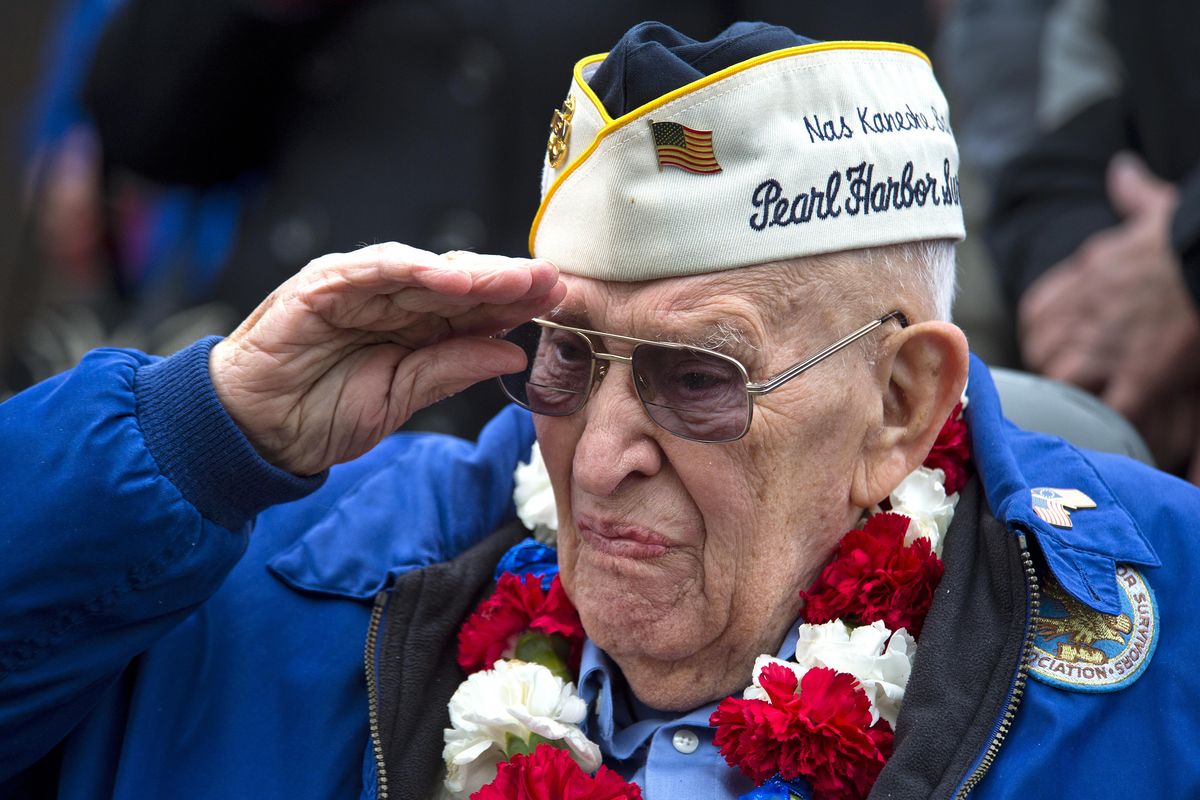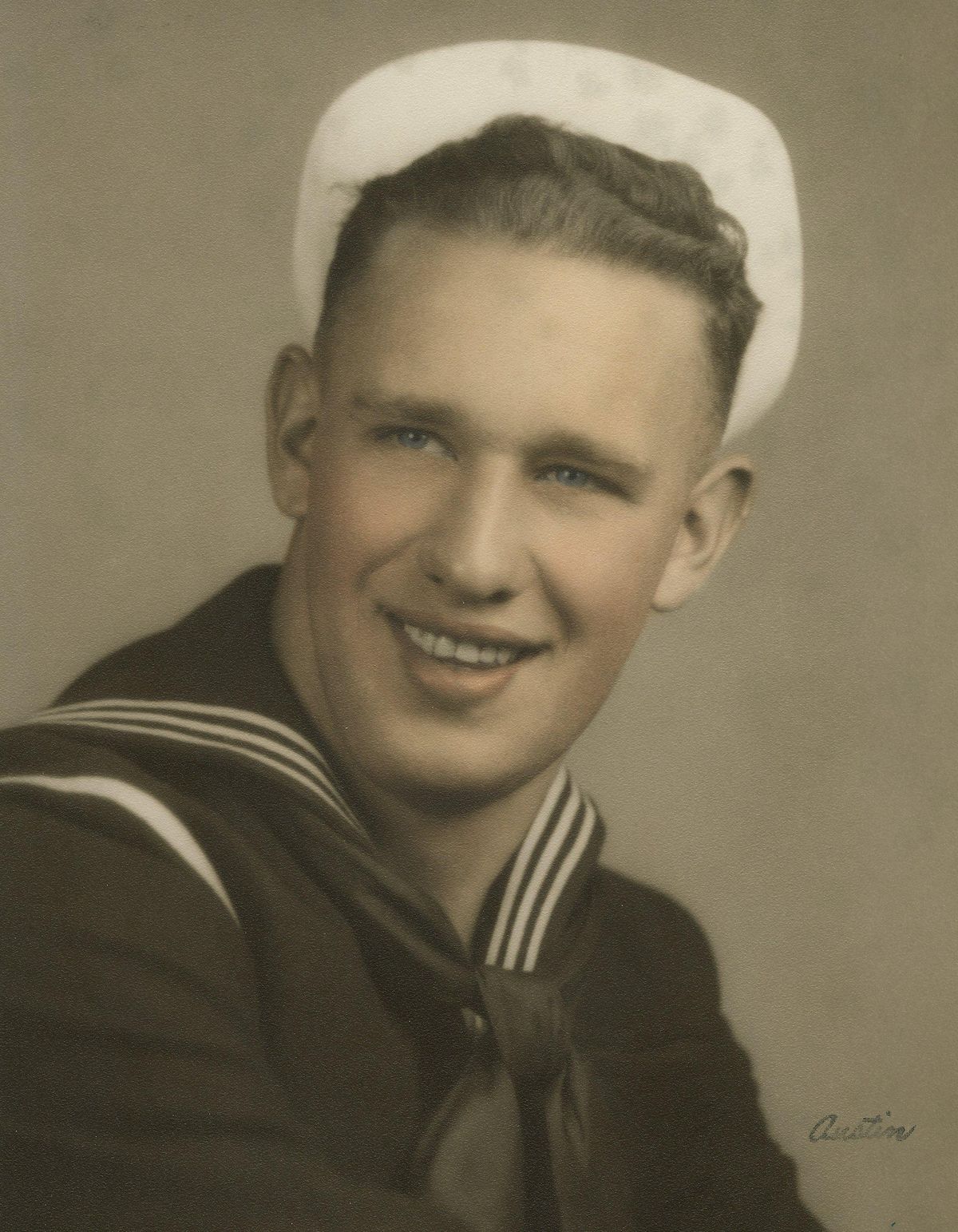Charles Boyer, Pearl Harbor survivor from Spokane Valley, remembered as cheerful and gentle
Pearl Harbor Survivor Charlie Boyer, in 2014, salutes the fallen during a ceremony at the Spokane Veterans Memorial Arena to commemorate the 73rd anniversary of the attack that began America’s involvement into World War II. (Dan Pelle / The Spokesman-Review)Buy a print of this photo
Originally published April 24.
The Patriot Guard Riders stood silently, their flags held aloft as a light rain fell at St. Mary’s Catholic Church in Spokane Valley.
They’d come to honor Charles Boyer, 95, who died April 15.
As a 21-year-old sailor stationed at Naval Air Station Kaneohe, Boyer had earned membership into an exclusive club: the Pearl Harbor Survivors Association.
Though he was an aviation machinist’s mate, Boyer was assigned to service and drive the Navy’s trucks at Kaneohe. The morning of Dec. 7, 1941, he’d just dropped off some sailors at church and was on his way back, when he saw several khaki-colored planes approaching fast and low.
In newspaper interviews, Boyer shared his memories of the horrific attack.
“I said, ‘Look at the show the Army’s putting on! Then I saw the big ol’ red meatballs on the wings of the plane and I said, ‘Army, hell!’ ” he recalled. “The planes were coming over us, shooting at us and dropping bombs.”
With the truck still moving, Boyer dove out and took shelter under another truck parked a few yards away.
He stayed under that truck until the enemy planes passed, then he ran to a large tin shed that served as a garage for the trucks at Kaneohe.
“Time seemed like forever,” he said. “I was pretty scared.”
He wasn’t the only one frightened. He told of a fellow sailor on guard duty who shot at a fence post. “He swore it moved,” he recalled, grinning.
But he didn’t smile when he talked about the results of the attack. Twenty Americans died on the base at Kaneohe that day, and as for the aircraft – “they did a hell of job,” Boyer said. “They got every warplane on Kaneohe.”
Four years and one day after the attack on Pearl Harbor, he married Irene Britton. They celebrated their 70th anniversary in December.
After 20 years, Boyer retired as a chief petty officer, but he couldn’t quite leave Navy life behind. He spent the next 22 years working in civil service for the Navy.
Upon moving to Spokane Valley in 1998, he joined the Lilac City Chapter of the national Pearl Harbor Survivors Association. He was especially close to fellow survivor John (Sid) Kennedy, whom he’d met in 1941 at aviation machinist school in San Diego. Later they were both sent to Kaneohe. Kennedy died July 7, 2015, and at his funeral Boyer told a friend, “I guess he went on ahead without me.”
At one time there were 125 active members of the Lilac City Chapter of the Pearl Harbor Survivors Association. Only one, Ray Garland, 93, remains.
Garland attended Boyer’s funeral.
“It’s kind of a lonely feeling,” he said.
Carol Edgemon Hipperson, author of the Ray Daves biography, “Radioman: An Eyewitness Account of Pearl Harbor and World War II in the Pacific,” also feels Boyer’s loss keenly.
“Charlie was much like Ray Daves to me,” she said. “Of all the Pearl Harbor survivors those two were the ones most like my own father: kind, gentle, soft-spoken, humble, voracious readers, towering intellects.”
She admired his cheerful spirit and compassion. “Most people get cranky when they don’t feel well or things don’t go right. Charlie never did. It was just his nature to smile and speak softly to everyone around him.”
Boyer’s son, Steve, agreed.
Three weeks ago as his father signed papers for hospice care, Steve Boyer choked up. His dad noticed his distress and said, “Don’t feel bad. I’ve had a great life – and a very, very long life.”
While many knew Charlie Boyer as a Pearl Harbor survivor, to his son, he was just Dad.
“I didn’t even know he was a Pearl Harbor survivor until he moved to Spokane Valley,” he said. “He never talked about it. He was just my dad and always will be. I’m going to miss him.”

